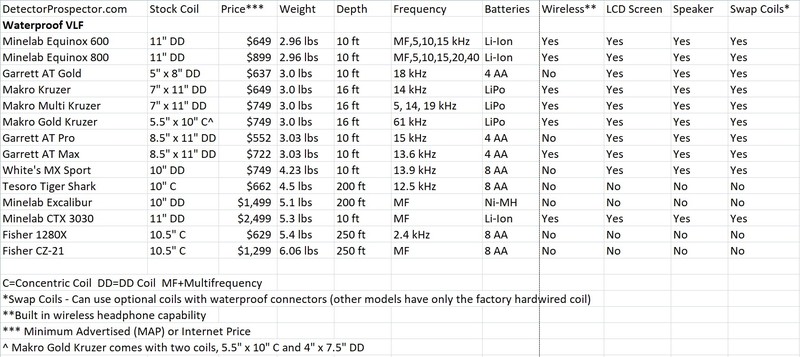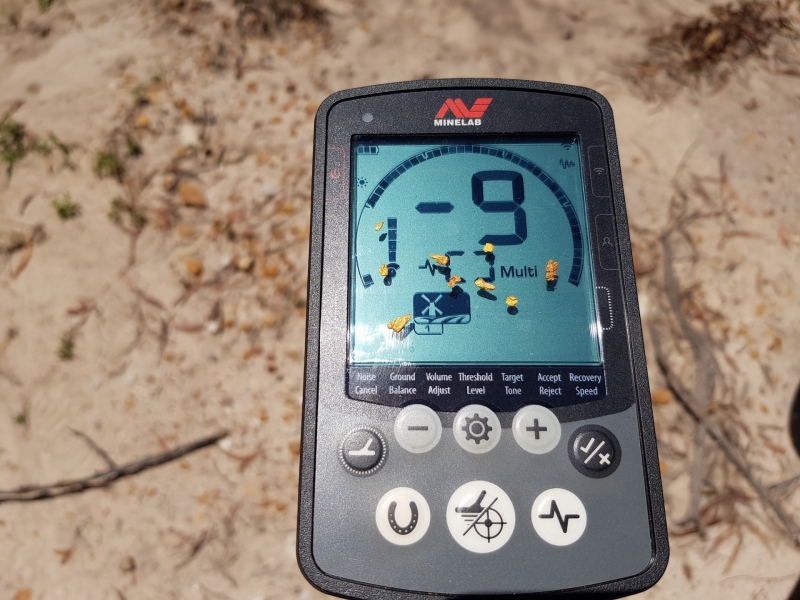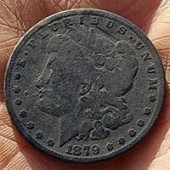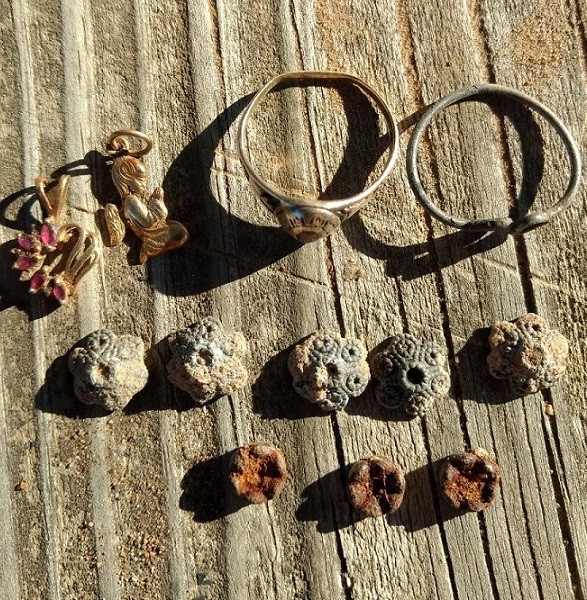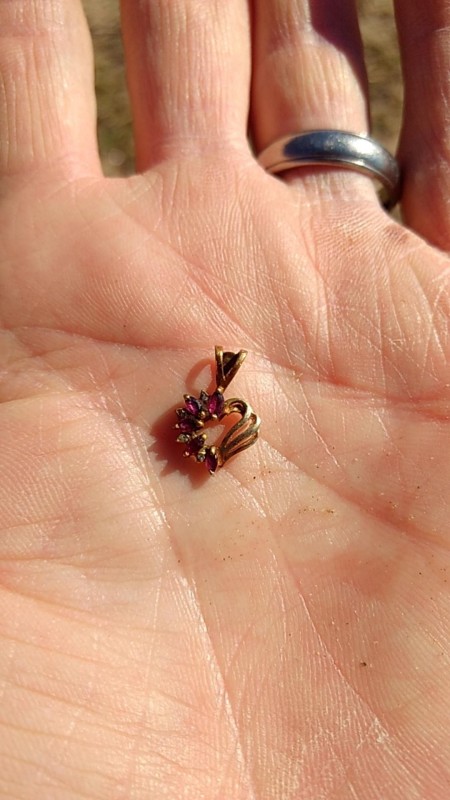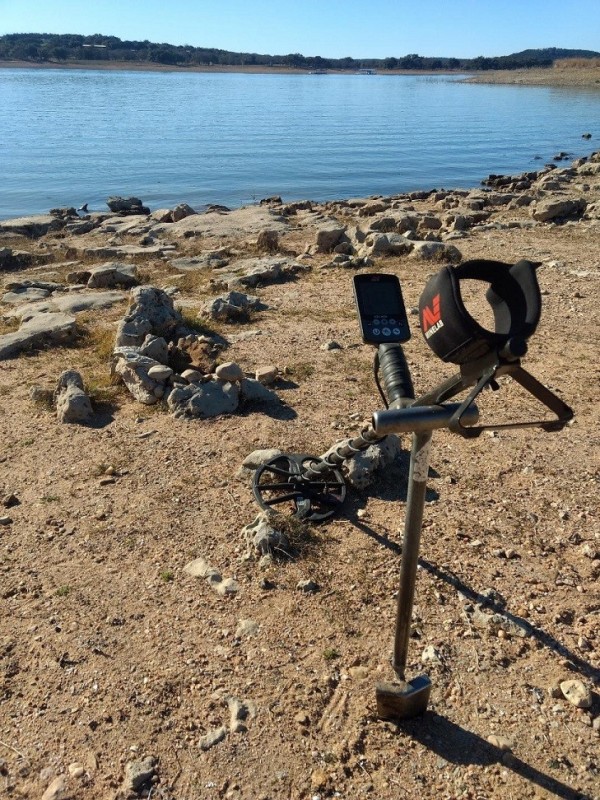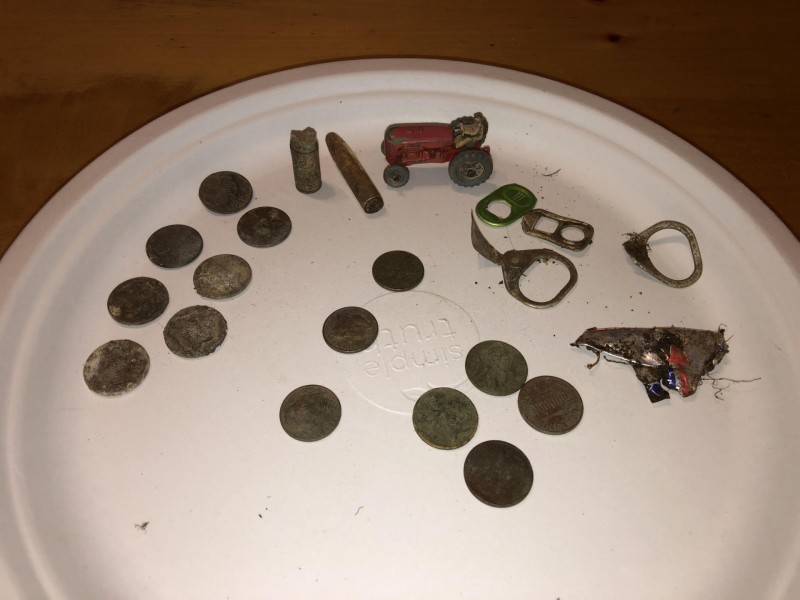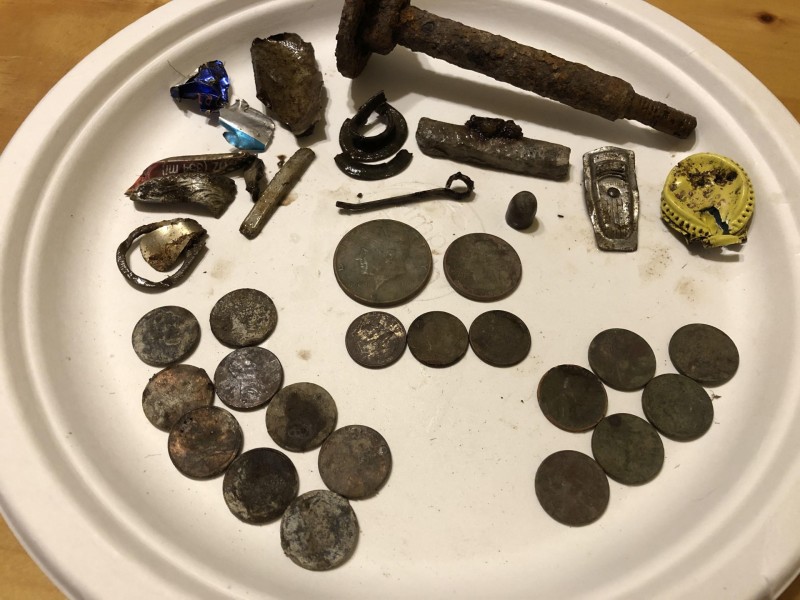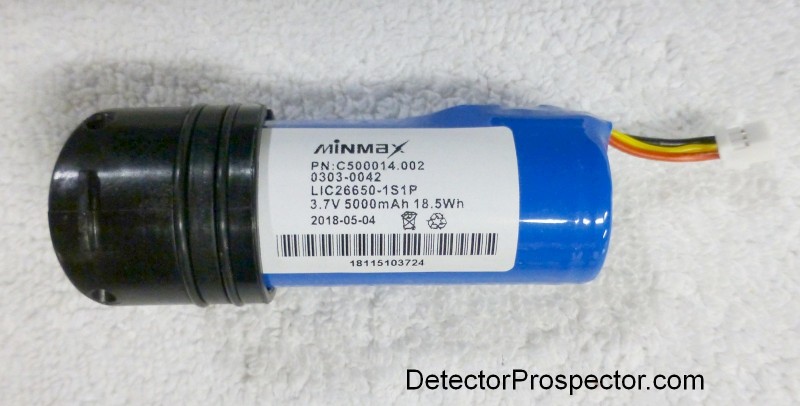Search the Community
Showing results for tags 'minelab equinox'.
-
Recently I was beach hunting with a friend (EQX 600) who detected almost exclusively in pinpoint mode and did very well. After watching him pull several silver coins out of the black sand and cobble, I asked him to let me try to hit his next target. Sure enough, my 800, beach 2, recovery 4, F2=0, full horseshoe, did not hit a silver dime. A few days later, I spent 3 hours trying his method. Using the same settings, beach 2 hit about 90% of the targets. The targets it missed were silver dime, wheat penny and copper bracelet. Does anyone know what frequency is used in pinpoint or what is different than regular modes? I tried targets in all metal with no success. Thanks
-
I keep reading comments by people who think the ergonomics of the Equinox are just horrible. Coming from my 7 lb harnessed GPZ 7000 the commentary is interesting. People do know the Equinox is a waterproof detector, right? My challenge? Please list all the waterproof metal detectors you think have better ergonomics out of the box than an Equinox. Current waterproof detectors from major manufacturers listed by weight. Click for larger version...
-
With the Equinox being such a versatile detector, I have used it in many different detecting situations. Lately I have been helping a local municipality try to find the exact location of a 19th century narrow gauge railroad right of way on some of their city land. The rails and cross ties were removed long ago and the terrain has been altered. So I’m looking for the iron relic debris along the railway roadbed for their museum and to trace the railroad’s location and any other period non ferrous targets too. I get to keep the non- ferrous ones!!!! One easy way to selectively find deep big iron targets with the Equinox like spikes, bolts and nuts, fish plates, etc. in Park or Field modes is to locate an iron target and then size it in pinpoint mode. We all know that the pinpoint feature can be a bit wonky sometimes. A friend of mine is helping me with this project and he is new to the Equinox (longtime CTX user). I was helping him setup his Nox in Park 2 and Field 1 and showing him how to ground balance and pinpoint. He didn’t know about the global and local settings difference so he just assumed that what he set in Field 1 applied to Park 2. He manually ground balanced Field 1 at 5 while Park 2 was unknowingly left on 0. The ground balance here can change from -2 to + 10 rapidly. I was trying to help him hear the difference between what to me sounded like a short 6” or so piece of barbed wire (correct assumption btw) still in the ground and what sounded to me like a much more dense piece of iron (turned out to be a spike). The pinpoint audio “halos” were very different on my Nox 600 and clearly outlined a long, thin target as opposed to a target whose audio halo was at least as big as my 11” coil. His Nox 800 was in Park 2 and in pinpoint mode it responded with a loud, long cats meow that lasted for his entire 4’ coil sweep over what turned out to be the barbed wire strand at 8” depth. He tried several times with the same result. I just figured he was continuing to press his pinpoint button but after checking he wasn’t. I tried his Nox and got the same result. I switched to Field 1 and his 800 pinpoint mode worked just like my Nox had. I switched back to Park 2 on his Nox and checked his settings and fixed the ground balance discrepancy by doing a ground grab which set at 4. I then went back into pinpoint mode on his Nox in Park 2 and it pinpointed just like his Field 2 and my similarly setup Nox 600. It appears that obtaining a good ground balance reading may improve pinpoint mode function on the Nox. I sure don’t remember seeing anything about that in the manual. So, I have always wondered what pinpoint mode was on the Nox since there is no classic All Metal mode. I have also wondered how smart (or not) it was to just simplify things and leave a Nox on 0 ground balance. This experience has reinforced my belief that taking the 30 seconds or less to do a ground grab now and then on this internally complex high gain detector during a hunt is definitely a smart idea. Jeff
-
I share an image of today. It is a beach, at low tide, and the sand is not too mineralized. I have always used the Beach1 mode, but I have doubts about using Beach2 (or other custom) Yes, I know that it is best to test - error, but some of you have a lot of experience, and that is why I would like to hear your comments and why. And if it's another way, I'm all ears. Thank you so much guys!
-
Hi everyone, I want make me sure if my program on my Detector is properly set or.. I own Equinox for 4 weeks and walked lot of km with it (90% of time on field). But I am still little confused about my settings to forest. I tryied with settings: field 1, 5 tone, disc -9 to 0, Rs 4 and iron bias 2. Our woods is pretty clear, so I can get more depth. (I am coin hunter) What I read or what I heard is that park 2 is more to depth than field 1.. But park 2 is more for dirty locations.. I'm from central Europe and local old silver coins are differently conductive because of their age and and size. what would you recommend? Park or field settings? I'm still trying to understand it and I'm still learning. I will be glad for your advice, I have not read anything about the forest anywhere in the topic. PS: sorry for my english I'm not native speaker Thank you
-
Here's a video of the Minelab Vanquish 540, Equinox 800 and eTrac comparing some targets while relic hunting. The area is challenging because there are not many targets left and the EMI is terrible. Steve if this should be under Comparisons feel free to move the post. Thanks
-
I am copying part of a post by Badger in NH on the Dankowski forum. Will this beach performance transfer over to hot dirt and more nuggets? I don't know but this guys results are certainly interesting. “For the depth testing I had a silver quarter, a silver dime and a medium sized mans 14k gold ring. I had drilled tiny holes in the center of the coins, ran a nylon string through each one and tied a knot on the end. This is to ensure that coins stay flat when buried. I would bury the coin at 15 inches and slowly pull the coin towards the surface a little at a time until it just came into detection range. When I reached the edge of the max depth that the coin could be detected, I grabbed the string where it came out of the sand, pulled up the coin and measured the length of the string. It worked perfectly. The gold ring is attached to the end of a fabric measuring tape. I tested the Tarsacci MDT 8000 against the Minelab Equinox 800. Settings were - Tarsacci - GB 600, SB 26-30 depending on Freq, Sense 7, Threshold 0, Disc 0, Mix mode. Equinox - Beach 1, Sense 23, 2 tones, AM on, recovery 6. To achieve a max depth designation, the detector must have a clear repeatable non-ferrous tone and reasonably accurate numerical ID. Tarsacci max depth on the silver Quarter was 13". Equinox was 10". Tarsacci max depth on the silver Dime was 12.5". Equinox was 9". (All the Tarsacci frequencies picked up the coins at max depth but 6.4 kHz sounded best.) Tarsacci max depth on the gold ring was 13". (All freqs picked it up but 18 kHz sounded best) Equinox had an iffy signal at 11" and 10" but only got a decent tone and ID at 9". I tried radically changing the GB number on the Tarsacci to see what that would do but came back to 600 because it got the best depth. I forgot to test Black Sand mode but will do that another time. So the Tarsacci wins the depth test by a large margin. I am extremely happy with it.” Tarsacci MDT 8000 Data & Reviews
-
I am new to running the EQ800 and following the manual to the advanced settings, it says to navigate to the recovery speed menu, then press and hold the settings button for the advanced settings bar to show up underneath the recovery speed icon. I do all that and no bar shows up, just a grunt. Other menu items come up with the bar underneath. Everything I read says there are advanced settings available, but I am not finding them. Am I missing something? I am running the most recent version of 2.0 and rolled back to 1.75 and it didn't seem to work there either. Am I doing something wrong?
-
- 7 replies
-
- vanquish
- minelab equinox
-
(and 1 more)
Tagged with:
-
I've hunted this fresh water beach the last 3 days with some decent luck. The first 2 days I hunted it with an Explorer 2 with an 8" coil, and did ok. I went back today with the Nox and did even better 🙂 My settings were: Park 2 2-tones 0-ground balance Disc -9 to 0 recovery speed 4 F2 0 sens 20 The gold ring hit a solid 12 the 2 little pendents rang at 1...found within 6" of each other. silver ring 5 open ring, not connected at the top silver beads 12, I've found 8 so far The little junk beads hit at 1 all the cleaned up silver was found with the Explorer 2
-
Received my Equinox 800 yesterday. Charged the detector and headphones up yesterday. Took my time putting it together and inspecting it. Rain and cold yesterday so no hunting. Today was different. Didn't even read the manual. Got it out this morning in the house and turned it on for first time. Ran a couple coins across the coil then went to tinkering a little bit. Park 1 stock except for threshold which I set to 3. FE to 3, left recovery speed at 5. notched out 39 and 40 , took the T1 volume down to 3 paired up my headphones and that was it. Took it to a place I had been one other time with my other detectors, and had really racked up with the other units there. Well.. The Equinox was doing really well today. 18 dimes, 6 quarters, 17 pennies 4 nickels, and a gold plated silver ring(my wife found that by eye!). less than 3 pulltabs dug today ( ID=14=pull tab for me). Used park 1 and nothing else. Didn't make any changes other than above. Ran sensitivity at 16-18. Some EMI was present so varied it according to that. Ground Balanced too. I did try 0 but found an actual ground balance did better. It handled that dreaded red dirt with gold specks like a boss! deepest find today was a copper penny at 8.5" down and under 3 different types of material (wood chip top, red dirt with gold specks, and sandy clay). I'm very happy with today's first outing and have no doubt I made the right choice in getting this unit. Seems I'm finally ready to appreciate all it has to offer. Gotta say the EQ600 I had earlier this year ran NOTHING like this unit. This thing is smooth and I can understand it. Almost forgot. I also had a piece of Skinomi techskin screen protector left over from when I bought it years ago for a tablet. Took a piece of paper and traced out the equinox control pod front as a template. Then I cut a piece best I could that would fit over the entire front, or most of it anyway. Managed to have just enough to cover the screen and buttons. So far that is working like a charm. Really cut down on the glare problem so many speak of. Had no trouble seeing the screen today.
-
Hello, brand new to the hobby, first post. So I ordered and received my 600 from Kellyco the other day. After using it for a bit I realized the backlight has many levels of adjustment. I turned it over and saw the “Equinox 800” sticker on the shaft. It does not have the gold mode or 20 & 40 kHz single frequency modes. So it’s like they ran of 600’s, and just grabbed an 800 and disabled the 800 features manually but left the multi backlight enabled. I haven’t checked any other 600/800 features. Has anyone else seen this? Thank you.
-
Hey everybody. Since I have bought the Equinox 800 as all of you know it comes with the WM08 module. I really don't hear of anyone much using that module. Minelab claims it has 17ms latency. Supposedly the AptX LL headphones have around 40ms latency. Coming from a computer/networking background I do realize there is a difference between these numbers. But in the real world of using the Equinox has anyone ran the WM08 and found it to be noticeably "quicker" than the wireless headphones? I have only been out on 1 hunt so far with the Equinox 800 and was very pleased and used the headphones. The headphones are very nice, very comfy to wear and have good audio. However I have a pair of gray ghost headphones I use with my Teknetics T2SE and really like them. I have ordered the headphone adapter cable from Digger's Den (Thanks again Brian for having the best price) and plan to try out the WM08 with the trusty gray ghosts. I don't feel it is necessary to baby the gray ghosts vs I do feel the minelab wireless headphones need more care and gentle handling. So again I ask, has anyone else used the WM08 and found it to be better in some way? It seems it is a waste to not put the module to work. Call it ignorance, but I want the lowest latency possible.
-
I recently tried Neil Jones's beach to land program - exactly as he advises. I don't know if I'm the problem or something else, but I was sorely disappointed, especially since I've read so many positive comments about it. I was on an iron infested colonial site with lots of EMI via livestock fencing. I was using the 6" coil. I hit 2 tombac buttons in factory Park 1. Switching to the custom program, the best I could get was broken signal that I would not have normally dug. Suggestions? Thoughts?
-
Hi, a good friend of mine lost his father about 5 years previously and has worn his fathers ring ever since. Four months ago my friend broke a bone in his hand and changed the ring to a finger on the other hand. The ring dropped off his finger as he was cutting the grass, unfortunately the mower was a ride on type and could have dropped off in any one of three small fields. Would I be better off switching to gold mode or leaving the equinox in field 2. In gold mode will it ignore all other metals(would save me a lot of time if it did ). Any ideas to my best approach? Regards Ed
-
My CTX had been in the shop for quite a while–it had the old config and leaked more than once. One bulkhead, one set of clips and two lithium cells later she was still drinking brine. Thanks to Minelab I’ve just gotten a like new machine and am very excited and grateful. (This must be what it’s like to complete a jihad and be granted a virgin in the afterlife)! Anyhow, I do a lot of testing in my basement in that the interference from furnace, household panel and dryer simulate actual tough salt surf conditions. If you can tune a detector inside–you are doing something right. This is especially true of big coils. I have the large coils for my CTX, Equinox 800 and a WOT hardwired for my Blue Tubes Excal. There is a ton to be learned about signal balancing big coils under these high interference conditions. This kind of testing has gotten me a lot of deep, heavy gold in conditions where there is a lot of pro-level competition. First, its amazing how much of a difference in performance loss (even in air) there is between large and stock coils. These big coils just suck the interference out of the air (or water). What I notice is that target sounds have a much more “inverse” .sound–as if the threshold was “taking over.” The higher you turn the Gain–the quieter targets get. In some instances–the stock coil actually hits targets further out. (Talk about a “teachable moment!)” One thing that’s worked well with the CTX has been to run a P2 version of one of the programs that features one or a couple of reject lines. (Andy’s Beach for example) This seems to balance the signal and reduce all the reverberation-type noise. This works well in the field too–especially of you don’t pile on more interference from current and any incline. This involves a slow sweep speed and working only North / South. I’ve gotten some rings down at the 20″ level this way. The Excalibur–as hard to tune with the WOT coil as it can be–is a simpler platform with less going on–electronically. While it can’t be run that high–maybe at 1 to 2 o’clock is a balanced signal–it does get great depth in discriminate–taking rings at an easy 18″-plus. It’s also stable. Now the Equinox is one of the hardest detectors to tune with a big coil that I’ve used. My usual 2 Tone method works–but is unstable and gets only moderate depth. My super-sharp responding gold magnet “Undertune” (GB -9 / tone “25”) method is out of the question. Without Ground Balancing–the threshold is lilting, uneven and requires careful coil control. I’ve seen videos of guys running down at “14” Gain–unacceptable. Why bother with a big coil to run that weak of a signal? The sense I have is that this detector has a hard time supporting a coil that size. When I run near-preset B2 with 5 Tones–it seems more balanced and stable. This is about the only time I’ve ever been driven back to the pre-sets to balance a detector. It’s a good coil–but hard to balance–just saying. I see a detection signal as being kind of like an arithmetic sum. When you keep subtracting with say, fast water, Gain too high, (in this case) Recovery Speed too fast, high saline conditions bottom contours / inclines and the work a detector does with a highly processed signal like that of the CTX or EQ–what’s left is not always enough to get any more depth than the stock coil. I’m still learning with both of these detectors / coils but am really struggling to get any respectable depth–especially with the EQ. I’ve a lot of great signal balancing “tricks” up my sleeve–including smoothing out the threshold with a “1” discriminate setting or even bringing up the Tone Break–but have yet to find anything that convinces me that a narrower–more manageable detection field drawing less interference would not perform better. I’ve also been instructed on the forums to keep the Recovery Speed low–down at “4” with the big EQ coil. This is just not that stable in salt conditions unless its absolutely still. Of the two, the CTX wins in terms of stability–but for coils that size–even compared to the WOT–the depth just does not seem to be enough to justify the extra swinging effort–at least not in salt water. I’m open to Equinox big coil salt water suggestions. Otherwise–next trip–the coil at least–is staying home. cjc
-
My new Equinox does not seem to have the newest firmware. I do not see the F2 option so pretty sure it is not the latest firmware. I've read varying opinions on the newest update. All sorts of things have been said, good and bad. Some say it has messed with the ID a bit too much and thrown them off from what it used to be. Some say the addition of F2 has been a good thing, others say nope. So, what do you think? Should I just run it like it is or is the new firmware somehow better in general? Curious is all and would enjoy hearing from anyone that cares to respond with their experiences and findings. Thanks for your time
-
This is less of a comparison and more of a question. It is a real head scratcher for me. I am not in any way trying to put down one detector and hype up another. This is just my experience. So, I recently had another try at the F75/T2/F70 platform. I have over 150 hours on these detectors and have now sold them all.......Why? My last go at this great group of detectors was with a 2016 F75LTD Special Edition with all of the latest features. After ten outings with it (about 40 hours) I have given up. Selling on Ebay right now with bids. My last work with it was at a city park that has such bad EMI that a Version 4 Omega 8000 and a T2+ were unusable there. This newer F75LTD had no audible issues with EMI at this park which for me anyway was a big improvement. My problem with it was determining a dig or not dig signal. At this park there is an audible signal every 2 or 3 inches, sometimes even closer. I did two field tests with the F75LTD 11"X7"DD and an Equinox 600 11" DD. Settings for the F75 were ground balance 87, Fe3O4 4 to 5 bars, DE mode, discrimination 15, 4 tones, sensitivity 80. Settings for the Nox 600 were ground balance 3, default Park 1 except for a bit of threshold tone set at 6 and sensitivity at 17 (even the Equinox can have EMI issues). I did use the horseshoe button a lot for iron ID. The first time I did this field test I did not want to believe the results. They were not pretty and were basically repeated in this second field test. So, I decided to try again. Both times I picked an area about 50 yards long and 2 yards wide, roughly a full sweep in one direction/lane and a return to the beginning in the adjacent lane. I marked the area off so I wouldn't stray or miss any ground. First I used the F75. Tons of signals, 1/4" aluminum shards are everywhere from shredded pop cans...... came up with 41 cents (3 clad dimes, 7 zinc pennies, 4 pre-1982 copper pennies) , a really cool HO scale tractor (I am a model train guy too, so great find, don't even have to weather it!) a shell casing and some pull tabs, etc. I did hit a really big target that sounded like big iron falsing by itself and did not dig it. There were so many iffy signals (at least to my ears and eyes with numbers and tones all over the place). I was only concentrating on two-way signals with generally consistent numbers and those are the targets I recovered. None were more than 6" deep. Next I covered the exact same ground with the Equinox. From the photos you can see that I or the F75LTD or a combination of both missed a lot of legitimate targets. It was easy to make the dig or no dig decision on these targets with the Nox 600. They were solid, two way, stable numbers and audio, no brainers. None were more than 8" deep and most were in the 2" to 4" range. The big iron screw had a clad dime that was 1" away from it and a little deeper than the top of the screw which was 3" below the surface. I heard the clad dime clearly both during sweeps and pinpointing, two separate obvious.targets. Lots of silver mercury dimes and wheat pennies in this area so I dug both targets. I only heard the iron with the F75. Also, there is no way using the Nox 600 that I would have missed the vast majority of the targets that I recoverd earlier with the F75. They were not difficult targets to recover. Also, except for the big iron screw and dime, I did not dig any targets with the Equinox 600 that were in previous F75 plugs or even adjacent to them, like within masking distance unless the F75 with the settings I was using can have masking issues with targets 4" apart........... So, I guess I am super spoiled by the Equinox.......or I seriously suck at the F75/T2 platform. Jeff These were recovered by the F75LTD These were recovered in the exact same ground afterwards by the Equinox 600. 1974 Kennedy half dollar, 1983 Washington quarter, 3 clad dimes 9 zinc pennies, 6 pre-1982 Memorial pennies, several pieces of lead and solid aluminum, etc.
-
Get the full scoop with photos at the Minelab Service Parts website. So far nobody appears to be selling the 3011-0405 battery but someday it will be something to possibly have to deal with. So far though I've not heard of any battery longevity issues... mine still give me a full day service and they are the oldest in the country. Replacement Minelab Equinox battery with battery door/plug (separate part)
-
Has anyone increased their 50 tone pitch from its default setting of 20 to max of 25? I want to receive the highest pitch that I can to closely resemble the sounds of the FBS machines, etrac, explorer, safari. I don’t quite get those flutey FBS sounds I would like to hear but the adjustment is as good as it’s going to get, I think. I’m assuming this shouldn’t change anything in areas of performance, because all I’m doing is simply increasing the audio pitch up and down the TID scale. Or is there something else to this once you go off of default settings? I thought I’d put this scenario out here to hear feedback from those who are hunting 50 tones set at a higher pitch opposed to its default setting of 20. I appreciate your feedback.
-
Ok.. I've encountered some really tough ground conditions in a lot of areas that I hunt regularly. We are talking the red dirt with little shiny particles all in it that also has iron mixed in. My Teknetics T2 struggles in it. My ORX struggles but will fish things out if you can stand the machine gun blips. I keep reading that the Equinox is more suited to deal with this. Now, I tried an Equinox 600 and found it to also cut up on certain plots of land, and the particular one I had was really horrible in iron. The tones also played tricks on my ears and I found the bleepity bling like sounds to confuse my caveman brain. The ORX has been a decent detector for me, and helped me rehabilitate myself after a car accident this year. However the tones in it are so close together that my ears can not often discriminate high from mid tone. There is no way to adjust it. Let's fast forward to today. The Equinox 600 does not have the adjustability of the 800 concerning tones, or at least that is my understanding. I walked away from my Equinox 600 ticked off that I could not seemingly bond with it. In my mind there was a single thought - how much better would the 800 be? For those of you that have especially used the XP ORX or the Teknetics T2 and also used an Equinox 800 I'm asking you, does the Equinox 800 do better in contaminated soil than my current 2? It is possible I will trade the XP ORX towards the EQ800. Would that be a "step-up" in capabilities? I've always found this forum and the people here honest and fair with no BS. So I ask you, would it be worth the extra money, hassle and such to truly give the Equinox 800 a chance even though I had a 600 and it didn't quite suit me. It is entirely possible the 600 I had may have had a fault of some type for all I know. And what of depth with the EQ800 vs the XP ORX? Reaching out to everyone in the know.
- 20 replies
-
- minelab equinox
- xp orx
-
(and 1 more)
Tagged with:
-
I’m in Kentucky. Highly mineralized ground. Full of square nails and horseshoes. What is everyones go to to hide the iron. I feel like I can’t get it to lock on? Why 50 tones over 5? Coming from at pro. Numbers have me messed up as I tried to pay attention to both Vdi and tone. I mainly hunt fields and some house sites. If u were to choose one setup from top to bottom what would it be. Deepest I’ve dug a bullets is 10 inches with the nox. Beach settings. For the future. Lol?
-
I've had my Eqx 800 for over 16 months and have operated it in the field over 300 hours. I have all three coils though usually swing the stock 11". Mostly I run in Park 1 but have experimented with all other modes. I've run with Recovery Speed in {4,5,6,7}, but typically start out in 5 and adjust from there as conditions dictate. I always run Iron Bias at 0. I almost always do an auto ground balance. Regardless of EMI I always start out with a Noise Cancel sequence as well. From day 1 I've had trouble with EMI. I never run gain higher than 22 and usually it's in {18,19,20} if I can get away with it. The town I live in has most of their power transmission lines underground, and usually either in the curb strip or (if there is no curb strip) under the street. Occasionally in the past I've had trouble with EMI with all my IB/VLF detectors, but nothing like what I experience with the Eqx 800. The noise cancel process never does much when the EMI is bad. When things are pretty quiet, that's when I notice a positive effect. If I can't get the Eqx stable in multi-IQ and gain of 17 I just switch to single frequency. Usually 5 kHz is noisy but I can almost always find a mid-frequency (usually 10 kHz and 15 kHz and always 20 kHz) that allows me to hunt with gain about 20, plus or minus. Thus I have an operating detector in the worst case, but I lose the power and features of multifrequency. This weekend the problem really became exacerbated. I received permission to hunt an 1850 homestead which I'm 90% certain has never been detected. Probably making matters worse was that I was salivating over the anticipated finds ("sugar plums dancing in my head"). When I got situated and turned on the Eqx I was blasted by EMI noise. After a while I realized I was right over (or very near) the underground power transmission lines on the property! (I didn't know they had 120V electricity in 1850. ?) As I got farther from the lines the detetor got quieter (not silent by any means) but in nearly 10 hours of hunting I was able to run multi-IQ less than an hour. The only frequency that was consistently quiet (gain on 19) was 20 kHz. 5 kHz surprisingly worked better than 10 kHz and 15 kHz. (I tend to shy away from running 40 kHz except when hunting native gold. 40 kHz was slightly noisier than 20 kHz when I checked.) In case you haven't surmised it from my tone, I had pretty much a bust weekend hunt -- 3 Wheat pennies, oldest 1940, being the highlight. A bit more evidence: I brought the Fisher F75 with Detech Ultimate 13" coil and it wouldn't quiet down either (ran the gain down to 30; there is a major gain shift going from 30 to 29 and things did quiet down below 30). To make matters worse, the area (not suprisingly) was inundated with nails. For most of the time I was running with Recovery Speed = 5 and getting about 6 or so grunts per (one way) swing. When I decided to try RS = 7 the rate doubled. Oh, the iron nails were so bad that I couldn't find quiet ground to do an auto GB, so just went with GB = 0. When I have problems/questions/concerns I always begin by looking at the most likely source -- the detectorist, then the ground/location. The last thing I do is blame the detector whether an individual case ('lemon') nor espeically the design. When I read reports here it seems lots of people run gains of 23-25 and others recover coins from 8-10 inches (even 12 in) of depth on dry land. The deepest coin I've ever found was no more than 7 inches deep, and I've found over 1500 coins with the Eqx. I know Steve H. in particular downplays those depths because of ground considerations but my ground, although not Florida sand, is still considerably milder than much of the US West. Occasionally posters talk about EMI problems but it seems to be an unusual occurrence, not nearly every time out like it is for me. In the recent thread on Dankowski's forum (http://www.dankowskidetectors.com/discussions/read.php?2,166825,page=1) which Steve H. called attention to, Tom D. mentions about how debilitating EMI is. Throw in ground issues and trash, especially iron, and modern IB detectors can still be fighting hard to distinguish/separate -- even give VDI hints at -- good targets. When my hunt fires blanks for old coins (which has been happening a lot lately), rather than thinking "there was nothing there to find" I feel I've left a lot in the ground. I really do have some good old sites and it boggles my mind there might be nothing left to recover. My first culprit is the EMI I have to deal with robbing me of opportunities (and iron trash is my second target). But after 300 hours I'm left wondering -- do I have an underperforming detector. Phrunt recently chronicalled his issue with grounding problems on his Teknetics T2 and how things improved after he found and fixed the problem. There has been much discussion about the potential wide variation in coil perfomance due to manufacturing inconsistencies. Is there a standard set of tests to find out if a detector is suffering from poor shielding or other EMI anomalies? Should I be contacting Minelab USA (and will they even believe me -- I'm sure they get lots of complaints by inexperienced detectorists)? Sorry for the long rant, but the losing streak is getting to me.


